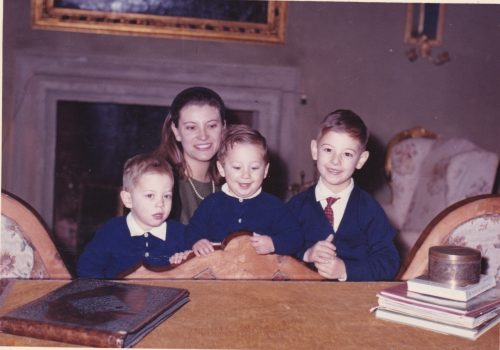
By Francesco Bianchini
The dining room of our old house was always a bit dark despite a big window overlooking the garden. In the evening, as in the daytime, it was necessary to keep the wrought-iron chandelier-lit, which sometime in the past, had suffered the indignity of electrification. From its amputated arms sprouted small light bulbs, an alien inflorescence, in tiers of six totaling thirty-six in all. It was a waste to let all those bulbs burn in broad daylight, everyone said – a belief that made my French-born mother smile because of the old Gallic saying, ‘whoever hits his head, sees thirty-six candles.’ The real cause of the room’s perpetual dimness was undoubtedly the musty green paint on the walls and all the dark furniture. The ceiling beams did have wan colors, painted with motifs hinting at legendary beasts – griffins, eagles, and grotesque dragons – and the large Renaissance fireplace was decorated with our family crest amidst a forest of leaves. The undulating expanse of the terracotta floor reflected what little light there was, a sanguine glow, but the carved beech convent table was, in the manner of olden times, stubbornly stained black.

The gloomy dining-room

The Empire of Light with apologies to Magritte, me at right dining with the Addams Family
When set for the holidays, my mother’s dinner ensembles preserved a faded image of an Umbria that once was: her colorful Deruta majolica, my grandmother’s dented silver jugs, their delicate crystal, and damask linen tablecloths – those woven on ancient looms in the convents of Bevagna and Montefalco, then starched and pressed with old-fashioned irons heated on the kitchen stove, left crisscrossed with creases. I loved the contrast between the sheen of the ceramics and the patina of the linen, and although ancient Faenza dinnerware was displayed on the walls, for her table Mamma invariably chose crockery from nearby Deruta. We had several such services that I instinctively associate with holiday meals: at Christmas, cappelletti in broth, cardoon parmigiana, roast capon with potatoes, all served on a pattern called Raffaellesco – winged orange serpents with darting blue tongues, almost human eyes. When there were really lots of us, the table had to be extended and mother paired the Raffaellesco with her Ricco – tangles of swirling plants and stylized flowers – and in the minutiae of their designs, no one noticed the two different sets. The Easter meal, usually tagliolini in broth, roast lamb, and potatoes seasoned with salt, pepper, and rosemary, conjures two further Deruta motifs, both considered more countrified: Arabesco – also called ‘violets’ – dotted with pretty blue flowers against dazzling white, and Galletto Verde, with its green roosters crowing amid jungles of winding vines. Easter lunch rarely benefitted from good weather, but if it was pleasant, the dining room window was left wide open, and the room was scented by early spring flowers in our garden. But more often, the fireplace still needed burning, and lunch was preceded by a family breakfast – the only formal one in our house – where we all sat down at the table at the same time. For that occasion the tablecloth was almost invisible, so many were the trays and serving dishes laden with capocollo and mortadella, prosciutto and salami, ricotta with honey, and pecorino; tall torte pasquali, cakes with cheese or raisins, and of course, baskets of hard-boiled eggs decorated by mother (and later by us kids) at a time when people didn’t pay much attention to the toxicity of colors.
 Mamma and three of her seven
Mamma and three of her seven
To buy majolica, my family always turned to Grazia, an enterprise handed down through generations of potters who began working in Deruta in the sixteenth century. I, too, am a regular customer and sometimes drop in – if only to cheer myself up. Display rooms on the ground floor have thousands of stacked pieces – plates, cups, jugs, bowls, and apothecary jars – and you can peep in at the decorators working on the second floor. It seemed like a magical world, dangerously fragile when I was dragged along as a child by my grandmothers and uncles who went there to buy gifts for every occasion. Majolica, they thought, was perfect for country homes, complementing the homespun tablecloths of Montefalco and Città di Castello; wildflower centerpieces, wicker baskets of homemade bread, living rooms with sofas and armchairs covered in toile de Jouy. They’d buy imposing sets of twenty-four or more place settings for a family that had always been prolific – but after the 1970s, with declining demographics, changing social mores, and skyrocketing prices, they plummeted downward, buying modest sets of six or eight. Outrageous, they’d complain, earthenware costs more than fine china! Not realizing that majolica is still made and painted by hand, while porcelain is now largely mass-produced.

Raffaellesco, Grazia faience, Deruta |

Ricco, Grazia faience, Deruta |

Galletto verde, Grazia faience, Deruta







